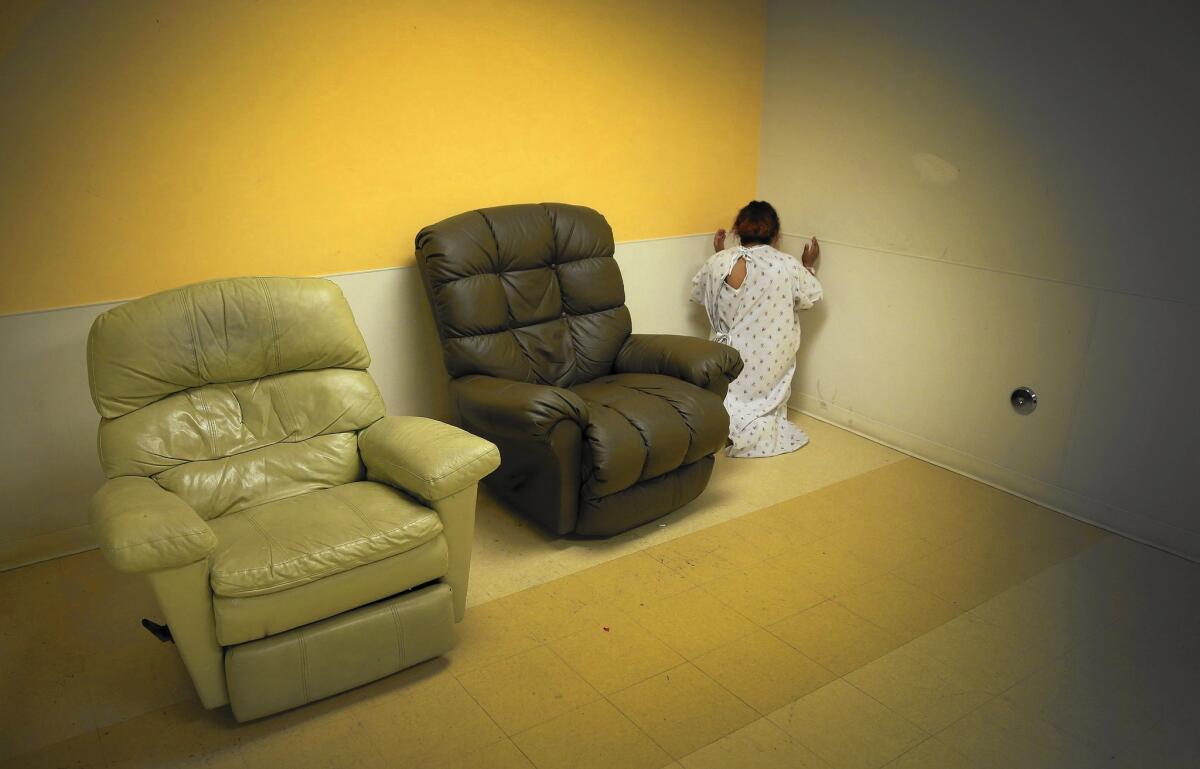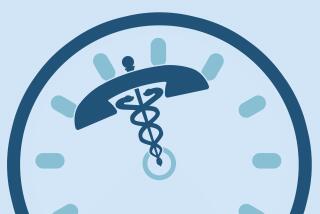County turns to urgent care centers, rather than jails or ERs, to treat the mentally ill in crisis

A patient prays at a psychiatric urgent care center in Boyle Heights in December.
- Share via
At the psychiatric urgent care center in Boyle Heights, a young woman wearing a nightgown knelt in a corner, praying in Spanish.
A repeat visitor, the woman had been picked up by police the day before after she left the board and care facility where she lives and was found standing in the street wearing only a bra. When asked how she had ended up at the urgent care center, the woman smiled shyly. “I forgot,” she said.
In the center’s lobby, Jennifer Rhaburn, 51, was waiting for her 26-year-old son. She had driven him to the center early that morning to get a prescription for medication to treat his psychosis. She said she had taken her son to other clinics after he woke up screaming and delusional the day before but had been told that he would have to wait as much as two months to get an appointment with a psychiatrist.
“I’m happy that I was able to get him help right away,” Rhaburn said. “I didn’t want him to wait two months to be seen.”
County mental health officials and police are increasingly looking to urgent care centers such as the facility in Boyle Heights as an alternative to jail beds or overcrowded psychiatric emergency rooms for people in the throes of a mental health crisis. There are now five such centers around the county, the newest of which opened last month, and the county plans to open four more over the next couple of years.
They provide short-term care for walk-in patients such as Rhaburn’s son and for people transferred from emergency rooms or brought in by police after being deemed a danger to themselves or others. The centers handled more than 27,000 visits last fiscal year.
At the opening ceremony last month for the newest urgent care facility, county Supervisor Mark Ridley-Thomas said the centers can help prevent crises from escalating and “avoid needless violence in our communities.”
See more of our top stories on Facebook >>
“Not only is it more humane, it is more cost effective, makes us better stewards of public resources, to build more urgent care centers than to build more jails,” he said.
It costs the county about $28 million a year to operate five centers, with much of that coming from state mental health funding and Medi-Cal. The cost per patient ranges from $200 to $900, depending on the level of care required.
Support for the facilities wasn’t always there. When the first county-contracted crisis center opened in 2006, it had to be placed inside a Culver City hospital because there were so many problems finding a neighborhood willing to take a stand-alone center, said Luana Murphy, head of Exodus Recovery, the contractor that runs three of the centers.
That first center shut down in 2014 after the hospital underwent changes but reopened last month at a new location on West Washington Boulevard. Four more have been established in Long Beach, Sylmar, Willowbrook and Boyle Heights.
Until recently, Los Angeles police were reluctant to take patients directly to the urgent care centers because, unlike hospital emergency rooms, the centers don’t take people with serious medical issues or who are extremely drunk or aggressive.
But after meeting with Exodus staff over the summer to clarify the guidelines, police have begun taking more patients to the centers rather than emergency rooms. In December 2014, law enforcement officers took 209 patients to L.A. County-USC Medical Center and 107 to the Exodus center across the street. In August, officers took 196 patients to the hospital and 268 to the urgent care center. LAPD officers who had been frustrated at the time they spent waiting to hand off patients to medical staff at the overcrowded county emergency rooms said the turnaround time is much quicker at the urgent care centers.
“The times I’ve been there, it’s been 15 minutes as opposed to two hours at the ER,” said Lt. Brian Bixler of the Los Angeles Police Department’s specialized mental health team.
NEWSLETTER: Get the day’s top headlines from Times Editor Davan Maharaj >>
The turn to urgent care centers has also helped to alleviate overcrowding at the county hospitals’ psychiatric emergency departments and in the regular emergency rooms. The average morning patient count for the three county psychiatric emergency rooms was about 40 in November, down from 60 a year earlier.
Mark Ghaly, director of community programs for the county’s Department of Health Services, which runs the hospitals, said a “significant amount” of the reduction in crowding can be attributed to the increased use of urgent care centers.
But the centers are limited in what they can provide. Unlike hospitals, which can hold patients found to be in a severe crisis for three days before releasing them or seeking a longer court-ordered stay, the centers can keep people for only 23 hours.
By that time, the vast majority of the patients have stabilized enough to be sent home or to a sober living facility or homeless shelter, Murphy said.
But it can be a challenge to find a bed in a psychiatric facility that provides long-term care. One patient waited a week at an urgent care center — in violation of rules — before an inpatient bed was found.
Ghaly said the expansion of urgent care centers will be a boon to hospitals, but needs to come with “a commensurate increase” in inpatient beds and community-based resources so patients have somewhere to go upon release.
The Boyle Heights center, a nondescript storefront across from L.A. County-USC, does not have patient beds. While the young woman prayed and Rhaburn waited for her son, some patients were still asleep on reclining armchairs. Others were eating breakfast, asking workers for a change of clothes or calling family members to arrange a ride home.
The staff made plans to have the young woman transferred to a hospital for longer-term care, while Rhaburn picked up her son’s medication from the pharmacy across the street and prepared to take him home. But after they got outside, he had another episode, Rhaburn said in an interview later.
He fell on the sidewalk and began going into contortions for more than 20 minutes, she said. Finally, the staff from the center brought him back in for an overnight stay. He was given medication and released the next morning with a referral to another clinic.
During the opening of the new Westside facility, Robin Kay, acting director of the county’s mental health department, recalled how families 10 years ago used to ask: “Where is the Department of Mental Health at night and on weekends, when you all go home and our family members, our loved ones, have an emotional or mental health crisis — where are you?”
She said the expanding network of crisis centers means that “we can say to those families, we are here.”
Twitter: @sewella
ALSO
What happened to El Niño? Be patient, L.A., it’ll come, expert says
Volunteers honor Martin Luther King Jr. by beautifying South L.A. schools
Bay Bridge’s westbound lanes reopened after rush hour protest; 25 arrested
More to Read
Sign up for Essential California
The most important California stories and recommendations in your inbox every morning.
You may occasionally receive promotional content from the Los Angeles Times.











